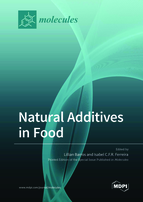Natural Additives in Food
A special issue of Molecules (ISSN 1420-3049). This special issue belongs to the section "Natural Products Chemistry".
Deadline for manuscript submissions: closed (31 January 2019) | Viewed by 128422
Special Issue Editors
Interests: natural bioactive compounds; medicinal chemistry; bioactivity and toxicology; functional applications
Special Issues, Collections and Topics in MDPI journals
Interests: food chemistry; natural products; functional foods
Special Issues, Collections and Topics in MDPI journals
Special Issue Information
Dear Colleagues,
The controversy and ambiguity related with chemical additives, allied to sporadic scares, have paved the way for natural additives to gain interest and funding. Today, most consumers prefer foods added with natural additives, rather than artificial ones, which is seen by the food industry as an opportunity to find new and more efficient natural-based solutions, while fighting to reduce the overall use of additives, producing minimally processed goods. The benefits of natural additives are endless, their synergy and effectiveness are a great leap over artificial additives that carry out, in most cases, only one effect over the food.
The plant and fungi kingdoms are great sources of bioactive compounds, that can be used to develop natural food ingredients. These natural compounds can be added as extracts, taking advantage of the synergistic effects between compounds, or as individual molecules, after purification, thus adding the most bioactive ones to the foodstuff. Although quite promising, natural additives still face some drawbacks and limitations. Therefore, an important research topic is the discovery of new alternative sources of natural additives fulfilling the different classes: preservatives (antimicrobials, antioxidants and anti-brownings), nutritional additives, coloring agents, flavoring agents, texturizing agents and miscellaneous agents.
This Special Issue “Natural Additives in Food” invites researchers to contribute with original research or review articles related to natural ingredients for food applications, including natural compounds obtained from plants, mushrooms, marine and bee products, extraction procedures, chemical identification, stabilization techniques, and food incorporation.
Dr. Lillian Barros
Prof. Dr. Isabel C.F.R. Ferreira
Guest Editors
Manuscript Submission Information
Manuscripts should be submitted online at www.mdpi.com by registering and logging in to this website. Once you are registered, click here to go to the submission form. Manuscripts can be submitted until the deadline. All submissions that pass pre-check are peer-reviewed. Accepted papers will be published continuously in the journal (as soon as accepted) and will be listed together on the special issue website. Research articles, review articles as well as short communications are invited. For planned papers, a title and short abstract (about 100 words) can be sent to the Editorial Office for announcement on this website.
Submitted manuscripts should not have been published previously, nor be under consideration for publication elsewhere (except conference proceedings papers). All manuscripts are thoroughly refereed through a single-blind peer-review process. A guide for authors and other relevant information for submission of manuscripts is available on the Instructions for Authors page. Molecules is an international peer-reviewed open access semimonthly journal published by MDPI.
Please visit the Instructions for Authors page before submitting a manuscript. The Article Processing Charge (APC) for publication in this open access journal is 2700 CHF (Swiss Francs). Submitted papers should be well formatted and use good English. Authors may use MDPI's English editing service prior to publication or during author revisions.
Keywords
- Bio-based compounds
- Extraction procedures
- Chemical characterization
- Food incorporation
- Stabilization techniques
- Functional foods








